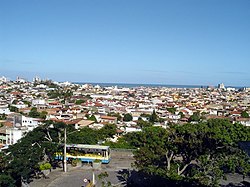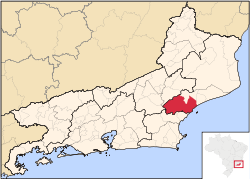Macaé
| Macaé | |||
|---|---|---|---|

Macaé skyline
|
|||
|
|||
| Nickname(s): "Princesinha do Atlântico, ou A Moreninha, ou Capital do Petróleo Brasileiro" Little Princess of Atlantic, or The Little Brunette or The Brazilian Capital Oil |
|||
 Location in the state of Rio de Janeiro and Brazil |
|||
| Location in the state of Rio de Janeiro and Brazil | |||
| Coordinates: 22°22′15″S 41°47′13″W / 22.37083°S 41.78694°WCoordinates: 22°22′15″S 41°47′13″W / 22.37083°S 41.78694°W | |||
| Country | Brazil | ||
| Region | Southeast | ||
| State | Rio de Janeiro | ||
| Founded | July 29, 1813 | ||
| Government | |||
| • Mayor | Aluízio dos Santos Júnior (PV) | ||
| Area | |||
| • Total | 1,216 km2 (469 sq mi) | ||
| Population (2016) | |||
| • Total | 239,471 | ||
| • Density | 159.88/km2 (413.91/sq mi) | ||
| Time zone | UTC-3 (UTC-3) | ||
| • Summer (DST) | UTC-2 (UTC-2) | ||
| Website | www.macae.rj.gov.br | ||
Macaé (Portuguese pronunciation: [mɐkɐˈɛ]) is a municipality located in the Brazilian state of Rio de Janeiro, 180 km northeast of the state capital.
Macaé is generally considered to be the centre of the Brazilian offshore petroleum industry and it is often referred to as "Cidade do Petróleo" ("City of Petroleum"). The Brazilian state-controlled oil company Petrobras has many facilities within the town. Macaé is one of the fastest-growing cities in Brazil, with a growth of 600% within the last 10 years.Benedito Lacerda Airport is served by scheduled flights and concentrates operations to off-shore platforms. Its population was recorded as 206,748 in 2010 and its municipality covers an area of 1,216 km².
Other economic activities in the city include tourism and fishing. These two sectors were very important for the city's revenues before the 1980s. The city has a growing reputation for high-quality technical education and training.
The municipality contains part of the Central Rio de Janeiro Atlantic Forest Mosaic of conservation units, created in 2006. It also holds part of the União Biological Reserve, home to a population of endangered golden lion tamarin. Although the city has some tourist potential, the lack of investments in this area makes its growth to be very small. Its most famous beaches are Cavaleiros and Pecado. The interior of the municipality has small rural towns such as Sana and Frade.
In 2009 the Brazilian Institute of Geography and Statistics (IBGE) estimated the population of Macaé as 194,413 inhabitants. The National Department of Transit (Denatran) census in 2003 recorded a fleet of 36,821 vehicles. According to the Electoral Regional Court (TRE-RJ), the number of voters registered in Macaé was 97,184 in 2004, divided in two electoral zones and 268 sections. In the last elections, 84,054 (200.49%) people voted.
...
Wikipedia



